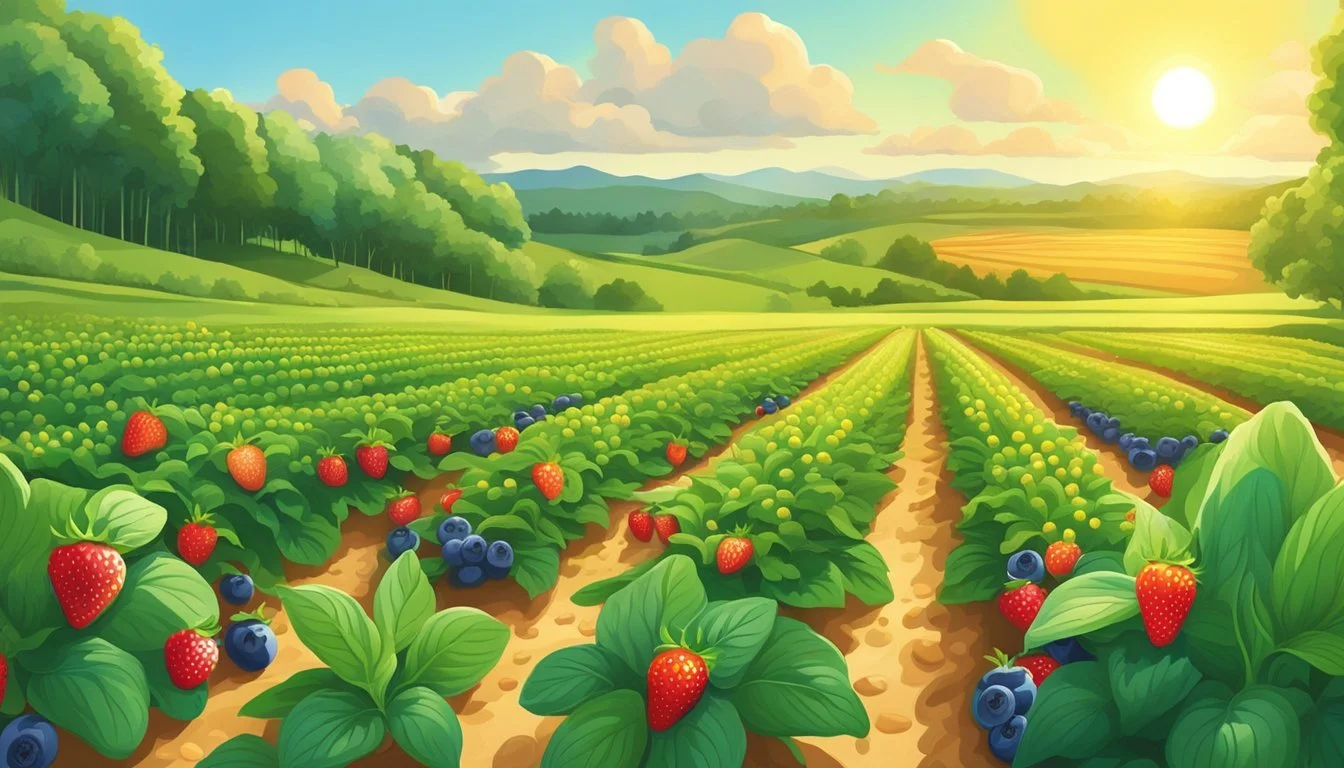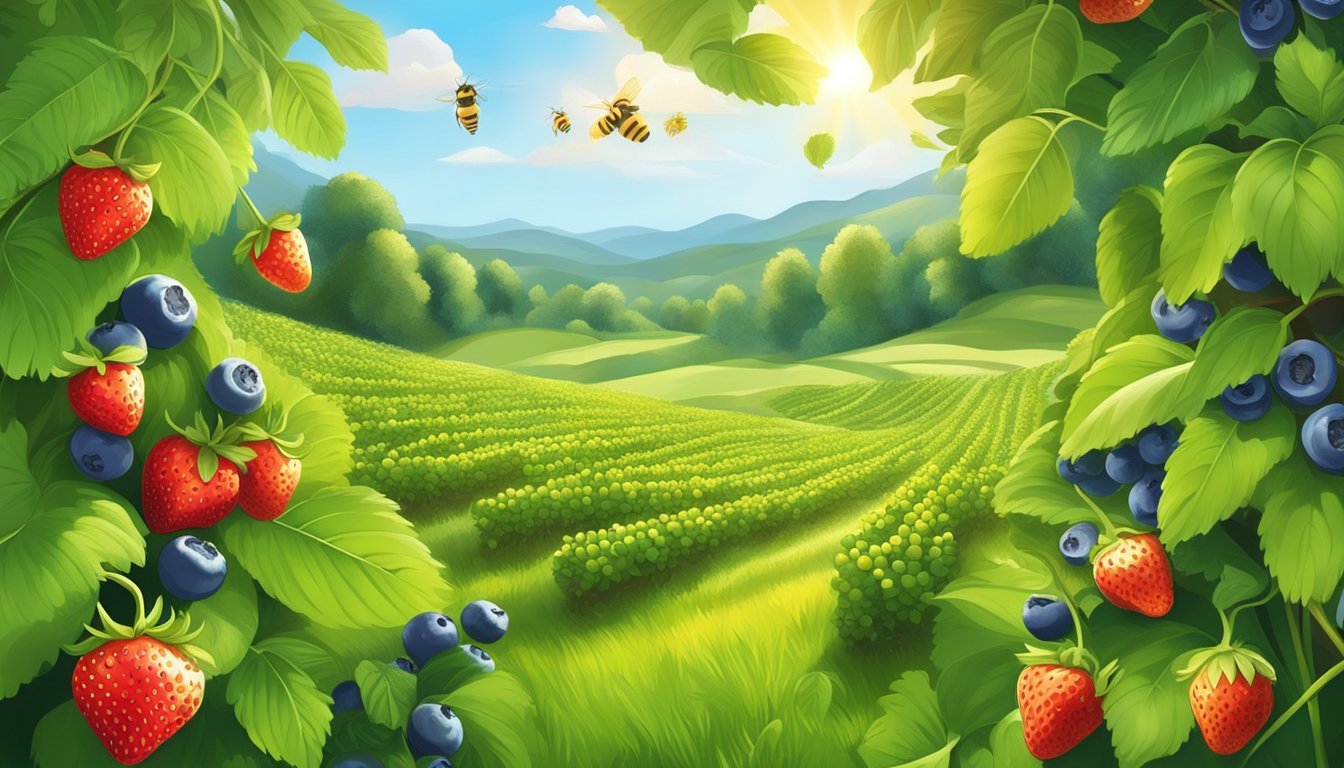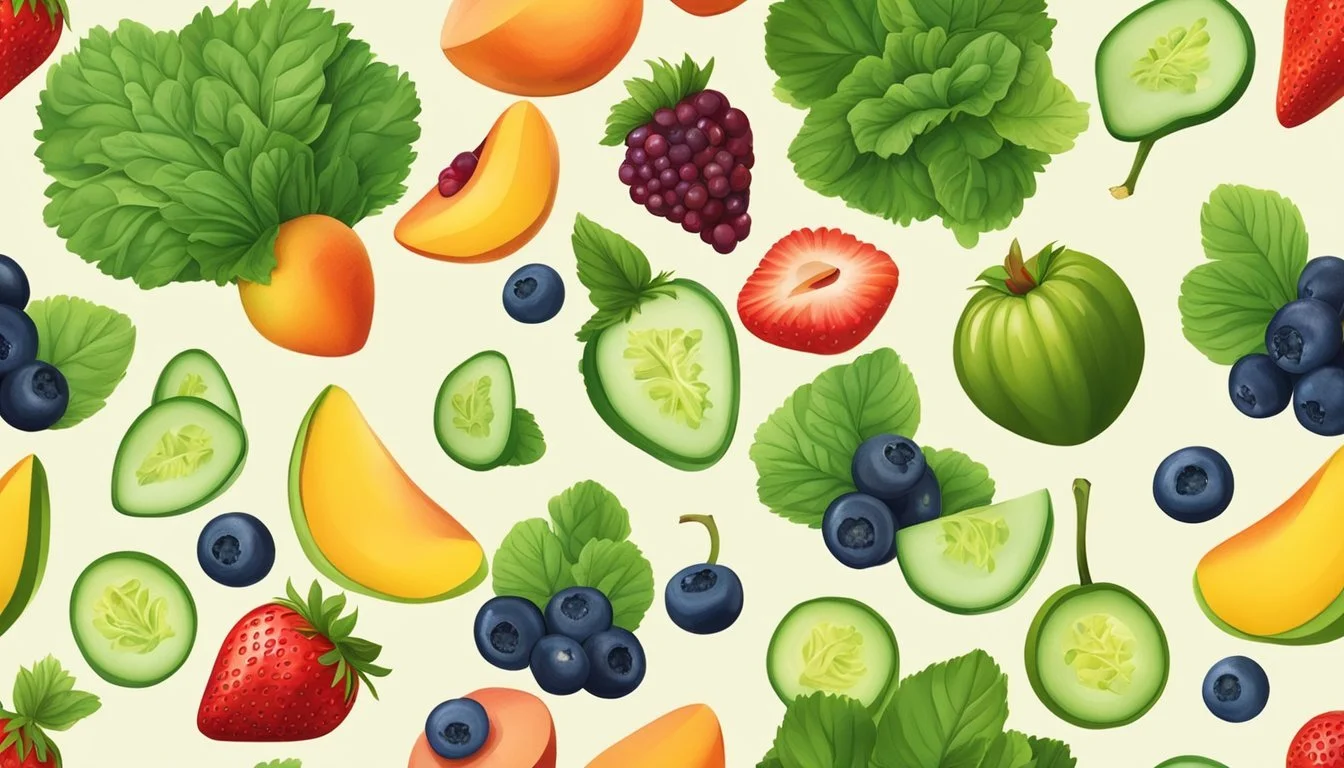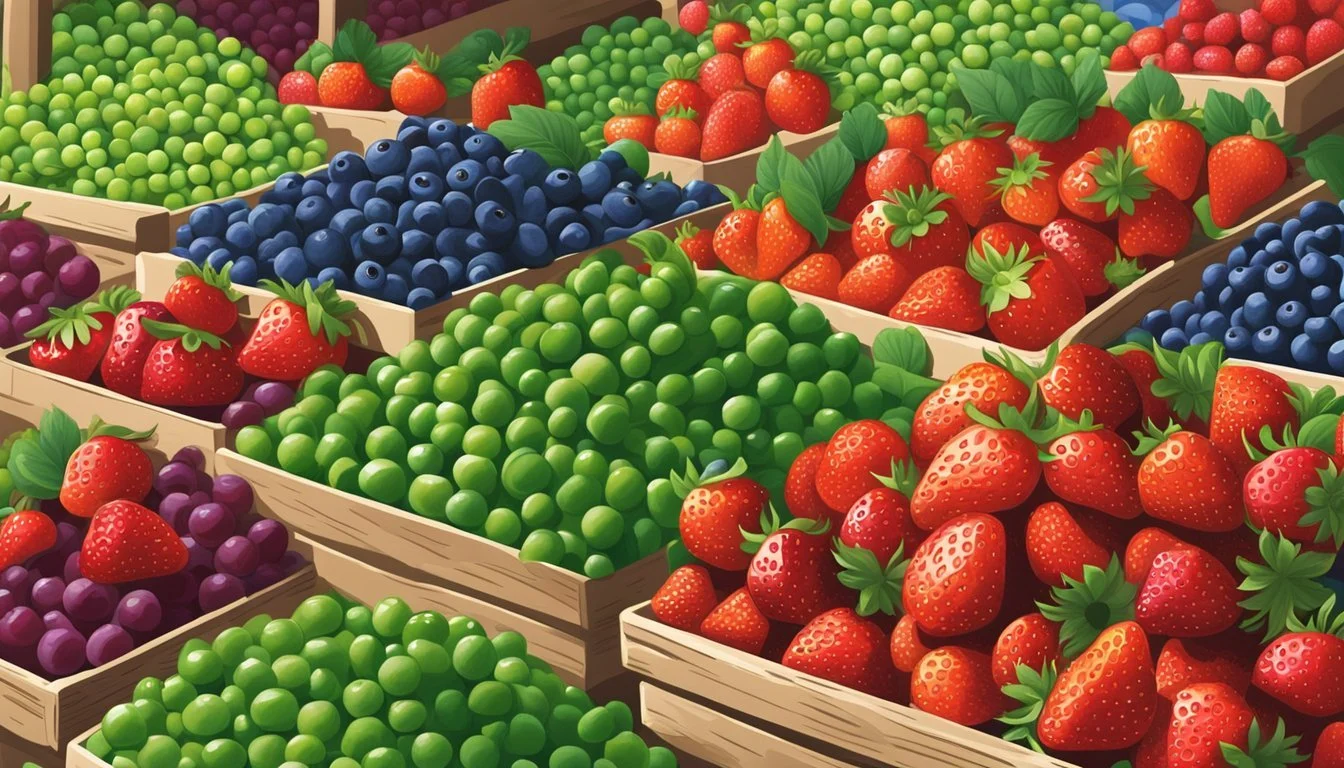Minnesota Seasonal Fruit & Vegetables in July
Your Fresh Guide
This Article is Part of our Minnesota Seasonal Fruit & Veg Calendar
Minnesota's summer season brings a bountiful harvest of fresh produce to local markets and home gardens. The warm July weather supports a wide variety of fruits and vegetables reaching their peak, providing local consumers with an array of colorful and nutritious options. State markets are vibrant with the season's best as Minnesotans take advantage of the fresh, locally grown offerings.
During July, the state's rich soil and good climatic conditions foster the growth of fruits such as blueberries, which become readily available this month. At the same time, vegetables like broccoli (how long does broccoli last?), carrots, and cauliflower (how long does cauliflower last?) flourish in gardens and farms across Minnesota. These seasonal delights are not only fresh but also packed with flavor, having been harvested at the height of their ripeness.
Shoppers and home cooks can refer to seasonal guides to help them identify which produce is available when planning their menus or garden plantings. This ensures that they can enjoy the freshest produce while supporting local agriculture and reducing the carbon footprint associated with long-distance food transport.
Understanding Minnesota's Growing Season
Minnesota's growing season is significantly influenced by its northern geographical location and varied climate. These factors dictate the types of fruits and vegetables that can be grown and the times of the year they are harvested.
Climate and Seasonality
Minnesota experiences a continental climate with cold winters and warm summers. This climate defines the growing season's start and end, which typically runs from late spring to early fall. July is in the heart of summer, during which Minnesota enjoys its longest days and warmest temperatures, often ranging from 60°F to 85°F. Summer in Minnesota is the peak time for a variety of produce and serves as a critical season for agriculture in the state.
Summer Harvest Times
During July, a number of fruits and vegetables reach their optimal harvest times. The warm and humid days followed by cooler nights make it an ideal period for growth and ripening. A snapshot of Minnesota's July harvest includes:
Fruits:
Blueberries (July into August)
Raspberries (June through August)
Strawberries (June and July)
Vegetables:
Broccoli (June through October)
Carrots (June through October)
Cauliflower (August through November)
Celery (August through October)
Sweet Corn (late July through September)
Tomatoes (July through September)
Understanding the harvest times is essential for both consumers and farmers, as these timeframes help predict when fresh, local produce will be available at markets, providing peak flavor and nutrition.
Seasonal Fruits in July
In July, Minnesota's farms become a showcase for a variety of ripe and flavorful fruits. Berry patches are particularly lush, stone fruits reach their peak succulence, and melons begin to ripen, offering a refreshing taste of summer.
Berries
During July, berries are at their prime. Among them, blueberries stand out for their plump and juicy qualities, making them perfect for both fresh eating and preserves. They're not only a local favorite but also packed with antioxidants. Similarly, raspberries add a burst of vibrant color and tangy flavor to the summer selection. Strawberries, although nearing the end of their season, can still be found ripe and sweet. Blackberries (how long do blackberries last?) may be on the rarer side, but when found, they are deep in color and rich in taste.
Blueberries: High in nutrients, perfect for desserts or snacking.
Raspberries: Ideal for fresh salads and sauces.
Strawberries: Best enjoyed fresh or in jams.
Blackberries: Great for baking and smoothies.
Stone Fruits
July also heralds the arrival of stone fruits, with peaches being the most sought after. They reach their juiciest stage in this month and are incredibly fragrant. Often used in pies, cobblers, and other desserts, peaches are a versatile fruit that encapsulates the warmth of the summer seasons.
Peaches: Juicy and fragrant, versatile in both sweet and savory dishes.
Melons
As summer heats up, so does the anticipation for melons. Watermelons and cantaloupes (how long does cantaloupe last?) begin to appear in markets, offering juicy, hydrating flesh that's perfect for hot July days. Their cool sweetness makes them a refreshing snack, a popular feature in fruit salads, or a creative addition to savory dishes.
Watermelons: Large, juicy, and best served chilled.
Cantaloupes: Sweet and tender, often paired with prosciutto.
Minnesota’s July bounty offers a wide range of flavorful fruits, ensuring that there is something to satisfy everyone's palate.
Seasonal Vegetables in July
July in Minnesota offers a bounty of fresh vegetables from various plant families. Garden enthusiasts and shoppers can expect robust flavors from nightshades such as tomatoes and peppers, cool cucurbits like cucumbers (how long do cucumbers last?) and zucchini, lush leafy greens including kale (What wine goes well with kale?) and spinach, hearty podded vegetables like green beans, and earthy root vegetables, including potatoes.
Nightshades
The nightshade family blooms in July, offering flavorful tomatoes and peppers of various sizes and heat levels. They thrive in the warm summer temperatures and provide a vibrant addition to any dish.
Tomatoes: Ideal for salads, sandwiches, and sauces.
Peppers: Range from sweet to fiery; perfect for grilling or stuffing.
Cucurbits
Cucurbits deliver refreshing tastes amid the summer heat. Cucumbers and zucchini are at their peak, yielding a crisp texture and refreshing flavor.
Cucumbers: Crisp and hydrating, suited for salads or as a snack.
Zucchini: Versatile for baking or sautéing; pairs well with herbs.
Leafy Greens
Leafy greens such as kale, lettuce, and spinach remain staples in the summer garden. These greens are rich in nutrients and are highly adaptable in the kitchen.
Kale: Hardy and full-bodied, perfect for salads or chips when baked.
Lettuce and Spinach: Tender and versatile, ideal for fresh salads or wilting into dishes.
Podded Vegetables
Podded vegetables like green beans are at their tender best. Their snappy texture and garden-fresh flavor enhance a multitude of recipes.
Green Beans: Can be steamed, boiled, or stir-fried; a summer favorite.
Root Vegetables
Root vegetables, particularly potatoes, can be unearthed in July. They offer earthy flavors and make an excellent base for summer meals.
Potatoes: Great for roasting, mashing, or as a salad component.
Practical Tips for Selecting and Storing Produce
When selecting fruits and vegetables, one must consider the ripeness and suitability for either immediate consumption or storage. Proper storage techniques ensure the longevity and freshness of the produce.
Choosing Ripe Produce
Fruits:
Apples: Look for firm fruits with no soft spots. Skin should be smooth without any wrinkles, indicating freshness.
Berries: Choose berries that are bright in color and plump, avoiding those that are mushy or have mold.
Vegetables:
Kale: Select dark green leaves that are crisp, avoiding yellowed or wilted edges.
Beets: Opt for firm beets with smooth skin. The smaller the beet, typically the more tender it will be.
Storage Recommendations
Fruits:
Apples: Store in a cool, dark place or in a refrigerator crisper drawer, away from strong-odored foods.
Berries: Keep in their original container in the fridge and wash only right before use to prevent mold.
Vegetables:
Kale: Refrigerate in a plastic bag; use within a few days for optimal freshness.
Beets: Remove the tops, store in the crisper, and they can last for weeks.
Preserved Options:
Canned: Ensure fruits and vegetables are canned at peak ripeness. Store in a cool, dry place.
Dried or Pickled: Keep in airtight containers; check labels for specific storage instructions as shelf life can vary.
Culinary Ideas for Minnesota Produce
July is an ideal time to explore the fresh flavors of Minnesota's seasonal fruits and vegetables. From vibrant salads and tangy salsas to sweet desserts and savory meals, there's a cornucopia of culinary opportunities.
Simple Summer Salads
Fresh salads are a staple during Minnesota summers. Utilize crisp greens like chard as a base and add sweet blueberries for a pop of flavor. A classic vinaigrette can be made more exciting by incorporating fresh herbs (how long do fresh herbs last?) available in July.
Blueberry and Chard Salad
Chard: Thinly slice for a tender bite
Blueberries: Sprinkle for a fruity surprise
Homemade Jams and Salsas
Homemade jams and salsas are a fantastic way to preserve the taste of summer. Berries reach their peak in July, offering the perfect balance of sweetness and acidity needed for exquisite jams. For salsas, tomatoes, another July treasure, can be diced and mixed with jalapeños and cilantro for that fresh garden taste.
Berry Jam
Berries (strawberries, blueberries): Crush and combine with sugar and lemon juice
Fresh Tomato Salsa
Tomatoes: Use ripe, juicy varieties
Desserts and Snacks
Treat yourself to desserts and snacks that showcase the sweetness of July's produce. Blueberries and strawberries can become the stars of pies, crumbles, or fresh fruit snacks. Lightly sweetened whipped cream or yogurt can accompany these fruits for a quick and delectable snack.
Strawberry Crumble
Strawberries: Slice and toss with a pinch of sugar for the filling
Cooking Farm-Fresh Vegetables
The bountiful harvest of vegetables in July, including broccoli, carrots, and cauliflower, provides an array of options for side dishes or main courses. Roasting these vegetables brings out their natural sugars, making them a perfect addition to any meal.
Roasted Veggie Medley
Carrots and Cauliflower: Chop and drizzle with olive oil before roasting
By incorporating Minnesota's July harvest into these culinary ideas, one can experience the freshness and quality that only local, seasonal produce can offer.
Finding Local Produce Markets
Minnesota is abuzz with local produce markets in July, offering a fresh array of fruits and vegetables directly from the summer's bounty. Consumers can visit various venues to purchase fresh produce, including Farmers Markets, Roadside Stands, and Community-Supported Agriculture (CSA) programs.
Farmers Markets
Farmers Markets are a staple throughout Minnesota for fresh, local produce. Shoppers can find a diverse assortment of seasonal fruits and vegetables. These markets are typically held weekly in numerous locations, such as city squares or public parks. In July, local staples often include sweet corn, tomatoes, and cucumbers.
Twin Cities Metro Farmers Market: Open Saturdays, 8am - 1pm.
Duluth Farmers Market: Open Wednesdays and Saturdays, 7am - 12pm.
Roadside Stands
For a quick and convenient stop, Roadside Stands dot the landscape of Minnesota, often run by the farmers themselves. These stands usually offer a selection of what’s most abundant in the fields. Seasonal highlights for July are likely to feature green beans, summer squash, and berries.
Prairie Yard Stand: Offers a range of sustainably grown produce.
Lake City Stand: Known for its juicy July peaches and plums.
Community-Supported Agriculture (CSA)
CSA programs connect consumers directly with local farms through a subscription service. Participants receive a shipment or pick up a share of the harvest throughout the growing season. Joining a CSA in July means regular access to fresh herbs, leafy greens, and ripe berries.
Riverside CSA: Provides weekly boxes with a mix of fruits and vegetables.
Harmony Valley CSA: Known for its variety and inclusion of recipe suggestions with each share.








